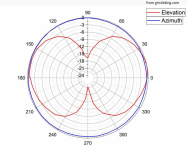In the Sti-co thread it's mentioned about the performance sacrifice of the tilted element. I know you guys will know all the numbers and charts, and have real-world experience with installs, so let me check my thinking with y'all.
I'm of the idea that the tilt may or may not affect the pattern as viewed from overhead, but that it does alter the take-off angle as viewed from the side by elevating the TOA on the more obtuse side of the angle. This could be OK or good in a valley with repeaters on the ridge, but in a place with broad, rolling hills could cause you to miss a repeater.
I'm sure there are other drawbacks as well with impedance and such, but am I thinking along the right lines? And I'm asking specifically about VHF and above. I can already make weird stuff radiate HF. 😆
I'm of the idea that the tilt may or may not affect the pattern as viewed from overhead, but that it does alter the take-off angle as viewed from the side by elevating the TOA on the more obtuse side of the angle. This could be OK or good in a valley with repeaters on the ridge, but in a place with broad, rolling hills could cause you to miss a repeater.
I'm sure there are other drawbacks as well with impedance and such, but am I thinking along the right lines? And I'm asking specifically about VHF and above. I can already make weird stuff radiate HF. 😆


